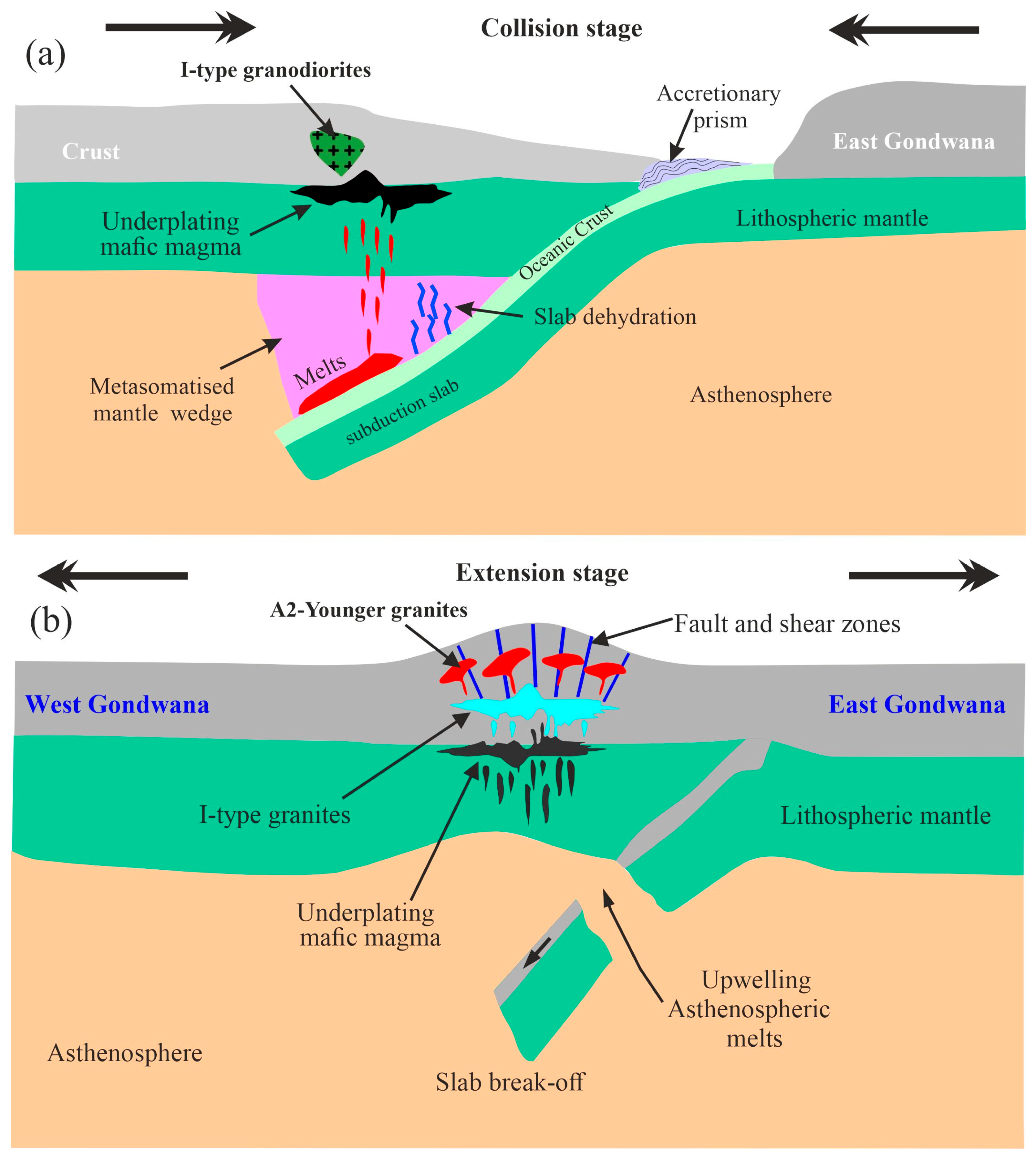Mineral Chemistry and Whole-Rock Analysis of Magnesian and Ferroan Granitic Suites of Magal Gebreel, South Eastern Desert: Clues for Neoproterozoic Syn- and Post-Collisional Felsic Magmatism
Abstract
1. Introduction
2. Methodology
3. Field Observations
4. Results
4.1. Petrography
4.2. Mineral Chemistry
4.3. Whole-Rock Geochemistry
4.3.1. Classification
4.3.2. Compositional Variations

5. Discussion
5.1. Lanthanide Tetrads
5.2. Thermobarometry Crystallization Conditions

5.3. Fractionation and Crustal Contamination
5.4. Magma Affinity and Tectonic Setting
5.5. Petrogenesis and Source of Magal Gebreel Felsic Plutonic Rocks
5.6. Geodynamic Modelling
6. Conclusions
- Magal Gebreel felsic magmatism comprise I-type (granodiorites) and A2-type (monzogranites, syenogranites, and alkali feldspar rocks).
- Granodiorites exhibit negative Ti, P, and Nb anomalies in their patterns and they are calcic, calc-alkaline, and magnesian. They are frequently developed by melting of high K-basaltic sources, exhibit a clear enrichment of LILEs in comparison to HFSEs, and are comparable with the volcanic arc granites.
- The A2-type of MGGs have low contents of Mg#, P2O5, MgO, Fe2O3, Sr, and Ti, and have large quantities of SiO2, Fe2O3/MgO, Nb, Zr, and Ga/Al. Additionally, they show a considerably negative anomaly in Eu and a slight elevation in LREEs compared to HREEs.
- The average temperature at which the Magal Gebreel rocks originated was 740, 723, 769, and 762 °C for granodiorite, monzogranites, syenogranites, and alkali feldspar rocks, respectively, according to the zircon saturation temperature (TZr). The rocks under examination originated from crustal components at a pressure of less than 3 kbar and a temperature ranging from 820 to 850 °C in the upper continental crust, according to the normative values of Magal Gebreel rocks.
Supplementary Materials
Author Contributions
Funding
Data Availability Statement
Acknowledgments
Conflicts of Interest
References
- Fowler, A.-R.; Hamimi, Z. Lithospheric Delamination in Models of Post-Collision Tectonics in the Egyptian Eastern Desert and Sinai: Claims versus Evidence. J. Afr. Earth Sci. 2023, 203, 104948. [Google Scholar] [CrossRef]
- Johnson, P.R.; Andresen, A.; Collins, A.S.; Fowler, A.R.; Fritz, H.; Ghebreab, W.; Kusky, T.; Stern, R.J. Late Cryogenian–Ediacaran History of the Arabian–Nubian Shield: A Review of Depositional, Plutonic, Structural, and Tectonic Events in the Closing Stages of the Northern East African Orogen. J. Afr. Earth Sci. 2011, 61, 167–232. [Google Scholar] [CrossRef]
- Saleh, G.M.; Kamh, S.Z.; Abdalla, F.; Kilias, A.; Lasheen, E.S.R. A New Occurrence of Rift-Related Damtjernite (Ultramafic) Lamprophyre, Gebel Anweiyib Area, Arabian Nubian Shield: Insights from Bulk Rock Geochemistry and Remote Sensing Data Analysis. Phys. Chem. Earth Parts A/B/C 2024, 133, 103530. [Google Scholar] [CrossRef]
- Saleh, G.M.; Kamar, M.S.; Khaleal, F.M.; Azer, M.K.; Nasr, T.; Lasheen, E.S.R. Petrogenesis and Tectonic Evolution of Tourmaline—Bearing Leucogranites, Sikait Area, Southeasten Desert of Egypt Utilizing Mineralogical and Bulk Rock Analysis. Sci. Rep. 2025, 15, 20191. [Google Scholar] [CrossRef] [PubMed]
- Stern, R.J.; Ali, K. Crustal Evolution of the Egyptian Precambrian Rocks. In The Geology of Egypt; Hamimi, Z., El-Barkooky, A., Martínez Frías, J., Fritz, H., Abd El-Rahman, Y., Eds.; Regional Geology Reviews; Springer International Publishing: Cham, Switzerland, 2020; pp. 131–151. ISBN 978-3-030-15264-2. [Google Scholar]
- Mokhtar, H.; Surour, A.A.; Azer, M.K.; Ren, M.; Said, A. Petrogenesis and Possible Fingerprints of the Najd Shear System on the Evolution of Deformed Granitic Rocks in the West Wadi Nugrus Area, Egypt. J. Afr. Earth Sci. 2023, 207, 105045. [Google Scholar] [CrossRef]
- Bonin, B. A-Type Granites and Related Rocks: Evolution of a Concept, Problems and Prospects. Lithos 2007, 97, 1–29. [Google Scholar] [CrossRef]
- Awad, H.A.; Zakaly, H.M.H.; Nastavkin, A.V.; El Tohamy, A.M.; El-Taher, A. Radioactive Mineralizations on Granitic Rocks and Silica Veins on Shear Zone of El-Missikat Area, Central Eastern Desert, Egypt. Appl. Radiat. Isot. 2021, 168, 109493. [Google Scholar] [CrossRef] [PubMed]
- Awad, H.A.M.; Zakaly, H.M.H.; Nastavkin, A.V.; El-Taher, A. Radioactive Content and Radiological Implication in Granitic Rocks by Geochemical Data and Radiophysical Factors, Central Eastern Desert, Egypt. Int. J. Environ. Anal. Chem. 2022, 102, 7444–7457. [Google Scholar] [CrossRef]
- El Dabe, M. New Occurrence of Polymetals Mineralized Pegmatites in The Older Granitoids, Wadi El Sheih Area, Central Eastern Desert, Egypt. Al-Azhar Bull. Sci. 2017, 28, 25–41. [Google Scholar] [CrossRef]
- Fangary, I.H.; Orabi, A.M.; Tolba, A.S.; Abd Elghany, M.K.; Mohamed, L.A.E. Geology and Geochemistry of Neoproterozoic Basement Rocks at Um Had Area, Central Eastern Desert, Egypt. Al-Azhar Bull. Sci. 2024, 35, 9. [Google Scholar] [CrossRef]
- Gaafar, M.; Ali, K. Geophysical and Geochemical Signature of Rare Metal Granites, Central Eastern Desert, Egypt: Implications for Tectonic Environment. Al-Azhar Bull. Sci. 2015, 26, 15–32. [Google Scholar] [CrossRef]
- Hassaan, M.M.; Omar, S.A.; Khalil, A.E.; Shahin, T.M.; El-Naggar, I.M.; Sayyed, M.I.; Hanfi, M.Y. Prognostic Exploration of U-F-Au-Mo-W Younger Granites for Geochemical Pathfinders, Genetic Affiliations, and Tectonic Setting in El-Erediya-El-Missikat Province, Eastern Desert, Egypt. Minerals 2022, 12, 518. [Google Scholar] [CrossRef]
- Lasheen, E.S.R.; Elyaseer, M.H.; Mohamed, W.H.; Azer, M.K.; Rashwan, M.A.; Thabet, I.A. Economic Feasibility of Gabal Um Takha Leucogranitic Intrusion, South Sinai, Egypt: Integrated Remote Sensing, Geochemical, Aeromagnetic, and Geotechnical Approach. Phys. Chem. Earth Parts A/B/C 2024, 133, 103531. [Google Scholar] [CrossRef]
- Stern, R.J. Neoproterozoic Formation and Evolution of Eastern Desert Continental Crust—The Importance of the Infrastructure-Superstructure Transition. J. Afr. Earth Sci. 2018, 146, 15–27. [Google Scholar] [CrossRef]
- Bentor, Y.K. The Crustal Evolution of the Arabo-Nubian Massif with Special Reference to the Sinai Peninsula. Precambrian Res. 1985, 28, 1–74. [Google Scholar] [CrossRef]
- Lundmark, A.M.; Gabrielsen, R.H.; Austrheim, H.; Flaat, K.; Strand, T.; Ohm, S.E. Late Devonian Rifting in the Central North Sea: Evidence from Altered Felsic Volcanic Rocks in the Embla Oil Field. Mar. Pet. Geol. 2012, 29, 204–218. [Google Scholar] [CrossRef]
- Azer, M.K.; Abdelfadil, K.M.; Asimow, P.D.; Khalil, A.E. Tracking the Transition from Subduction-related to Post-collisional Magmatism in the North Arabian–Nubian Shield: A Case Study from the Homrit Waggat Area of the Eastern Desert of Egypt. Geol. J. 2020, 55, 4426–4452. [Google Scholar] [CrossRef]
- El-Awady, A.; Sami, M.; Abart, R.; Fathy, D.; Farahat, E.S.; Ahmed, M.S.; Osman, H.; Ragab, A. Petrogenesis and Tectonic Evolution of I- and A-Type Granites of Mount Abu Kibash and Tulayah, Egypt: Evidence for Transition from Subduction to Post-Collision Magmatism. Minerals 2024, 14, 806. [Google Scholar] [CrossRef]
- Lasheen, E.S.R.; Abart, R.; Ahmed, M.S.; Abdelfadil, K.M.; Farahat, E.S.; Sami, M. Petrological Constraints of the Ediacaran Magmatic Intrusions, Homrit Mukpid Area, Southeastern Desert, Egypt: Bulk Rock Geochemistry and Mineralogy. J. Afr. Earth Sci. 2025, 225, 105567. [Google Scholar] [CrossRef]
- Whalen, J.B.; Currie, K.L.; Chappell, B.W. A-Type Granites: Geochemical Characteristics, Discrimination and Petrogenesis. Contrib. Mineral. Petrol. 1987, 95, 407–419. [Google Scholar] [CrossRef]
- Sami, M.; Ntaflos, T.; Mohamed, H.A.; Farahat, E.S.; Hauzenberger, C.; Mahdy, N.M.; Abdelfadil, K.M.; Fathy, D. Origin and Petrogenetic Implications of Spessartine Garnet in Highly-Fractionated Granite from the Central Eastern Desert of Egypt. Acta Geol. Sin.-Engl. Ed. 2020, 94, 763–776. [Google Scholar] [CrossRef]
- Seddik, A.M.A.; Darwish, M.H.; Azer, M.K.; Asimow, P.D. Assessment of Magmatic versus Post-Magmatic Processes in the Mueilha Rare-Metal Granite, Eastern Desert of Egypt, Arabian-Nubian Shield. Lithos 2020, 366–367, 105542. [Google Scholar] [CrossRef]
- Lasheen, E.S.R.; Rashwan, M.A.; Azer, M.K. Effect of Mineralogical Variations on Physico-Mechanical and Thermal Properties of Granitic Rocks. Sci. Rep. 2023, 13, 10320. [Google Scholar] [CrossRef] [PubMed]
- Rashwan, M.A.; Lasheen, E.S.R.; Abdelwahab, W.; Azer, M.K.; Zakaly, H.M.H.; Alarifi, S.S.; Ene, A.; Thabet, I.A. Physico-Mechanical Properties and Shielding Efficiency in Relation to Mineralogical and Geochemical Compositions of Um Had Granitoid, Central Eastern Desert, Egypt. Front. Earth Sci. 2023, 11, 1228489. [Google Scholar] [CrossRef]
- Saleh, G.M. Uranium Mineralization in the Granitic Rocks of Nasb Aluba—Magal Gebriel Area, South Eastern Desert, Egypt; Nuclear Material Authority: New Cairo, Egypt, 2001. [Google Scholar]
- Deer, W.A.; Howie, R.A.; Zussman, J. An Introduction to the Rock Forming Minerals, 2nd ed.; Longman Scientific and Technical: London, UK, 1992. [Google Scholar]
- Nachit, H.; Ibhi, A.; Abia, E.H.; Ben Ohoud, M. Discrimination between Primary Magmatic Biotites, Reequilibrated Biotites and Neoformed Biotites. C. R. Geosci. 2005, 337, 1415–1420. [Google Scholar] [CrossRef]
- Miller, C.F.; Stoddard, E.F.; Bradfish, L.J.; Dollase, W.A. Composition of Plutonic Muscovite; Genetic Implications. Can. Mineral. 1981, 19, 25–34. [Google Scholar]
- Monier, G.; Mergoil-Daniel, J.; Labernadière, H. Générations successives de muscovites et feldspaths potassiques dans les leucogranites du massif de Millevaches (Massif Central français). Bull. Minéralogie 1984, 107, 55–68. [Google Scholar] [CrossRef]
- Clarke, D.B. The Mineralogy of Peraluminous Granites; a Review. Can. Mineral. 1981, 19, 3–17. [Google Scholar]
- Leake, B.E.; Woolley, A.R.; Arps, C.E.S.; Birch, W.D.; Gilbert, M.C.; Grice, J.D.; Hawthorne, F.C.; Kato, A.; Kisch, H.J.; Krivovichev, V.G.; et al. Nomenclature of Amphiboles; Report of the Subcommittee on Amphiboles of the International Mineralogical Association Commission on New Minerals and Mineral Names. Mineral. Mag. 1997, 61, 295–310. [Google Scholar] [CrossRef]
- Keeditse, M.; Rajesh, H.M.; Belyanin, G.A.; Fukuyama, M.; Tsunogae, T. Primary Magmatic Amphibole in Archaean Meta-Pyroxenite from the Central Zone of the Limpopo Complex, South Africa. S. Afr. J. Geol. 2016, 119, 607–622. [Google Scholar] [CrossRef]
- Hawthorne, F.C.; Oberti, R.; Harlow, G.E.; Maresch, W.V.; Martin, R.F.; Schumacher, J.C.; Welch, M.D. Nomenclature of the Amphibole Supergroup. Am. Mineral. 2012, 97, 2031–2048. [Google Scholar] [CrossRef]
- Hoskin, P.W.O.; Schaltegger, U. The Composition of Zircon and Igneous and Metamorphic Petrogenesis. Rev. Mineral. Geochem. 2003, 53, 27–62. [Google Scholar] [CrossRef]
- Tindle, A.G.; Breaks, F.W. Columbite-Tantalite Mineral Chemistry from Rare-Element Granitic Pegmatites: Separation Lakeh Area, N.W. Ontario, Canada. Mineral. Petrol. 2000, 70, 165–198. [Google Scholar] [CrossRef]
- Mahdy, N.M. Textural and Chemical Characteristics of Zircon, Monazite, and Thorite, Wadi Al-Baroud Area, Eastern Desert of Egypt: Implication for Rare Metal Pegmatite Genesis. Ore Geol. Rev. 2021, 136, 104225. [Google Scholar] [CrossRef]
- Middlemost, E.A.K. Naming Materials in the Magma/Igneous Rock System. Earth-Sci. Rev. 1994, 37, 215–224. [Google Scholar] [CrossRef]
- Streckeisen, A.L.; Le Maitre, R.W. A Chemical Approximation to the Modal QAPF Classification of the Igneous Rocks. Neues Jahrb. Fur Mineral. Abh. 1979, 136, 169–206. [Google Scholar]
- Frost, B.R.; Frost, C.D. A Geochemical Classification for Feldspathic Igneous Rocks. J. Petrol. 2008, 49, 1955–1969. [Google Scholar] [CrossRef]
- Sun, S.-S.; McDonough, W.F. Chemical and Isotopic Systematics of Oceanic Basalts: Implications for Mantle Composition and Processes. Geol. Soc. Lond. Spec. Publ. 1989, 42, 313–345. [Google Scholar] [CrossRef]
- Yang, S.-Y.; Jiang, S.-Y.; Zhao, K.-D.; Jiang, Y.-H.; Ling, H.-F.; Luo, L. Geochronology, Geochemistry and Tectonic Significance of Two Early Cretaceous A-Type Granites in the Gan-Hang Belt, Southeast China. Lithos 2012, 150, 155–170. [Google Scholar] [CrossRef]
- Hermann, A.G. Yttrium and lanthanides. In Handbook of Geochemistry; Springer: Berlin, Germany, 1970; pp. 57–71. [Google Scholar]
- Irber, W. The Lanthanide Tetrad Effect and Its Correlation with K/Rb, Eu/Eu∗, Sr/Eu, Y/Ho, and Zr/Hf of Evolving Peraluminous Granite Suites. Geochim. Cosmochim. Acta 1999, 63, 489–508. [Google Scholar] [CrossRef]
- Kawabe, I. Lanthanide Tetrad Effect in the Ln3+ Ionic Radii and Refined Spin-Pairing Energy Theory. Geochem. J. 1992, 26, 309–335. [Google Scholar] [CrossRef]
- Anenburg, M.; Williams, M.J. Quantifying the Tetrad Effect, Shape Components, and Ce–Eu–Gd Anomalies in Rare Earth Element Patterns. Math. Geosci. 2022, 54, 47–70. [Google Scholar] [CrossRef]
- Masuda, A.; Kawakami, O.; Dohmoto, Y.; Takenaka, T. Lanthanide Tetrad Effects in Nature: Two Mutually Opposite Types, W and M. Geochem. J. 1987, 21, 119–124. [Google Scholar] [CrossRef]
- Jahn, B.; Wu, F.; Capdevila, R.; Martineau, F.; Zhao, Z.; Wang, Y. Highly Evolved Juvenile Granites with Tetrad REE Patterns: The Woduhe and Baerzhe Granites from the Great Xing’an Mountains in NE China. Lithos 2001, 59, 171–198. [Google Scholar] [CrossRef]
- Basak, A.; Goswami, B. The Physico-Chemical Conditions of Crystallization of the Grenvillian Arfvedsonite Granite of Dimra Pahar, Hazaribagh, India: Constraints on Possible Source Regions. Mineral. Petrol. 2020, 114, 329–356. [Google Scholar] [CrossRef]
- Watson, E.B.; Harrison, T.M. Zircon Saturation Revisited: Temperature and Composition Effects in a Variety of Crustal Magma Types. Earth Planet. Sci. Lett. 1983, 64, 295–304. [Google Scholar] [CrossRef]
- Rudnick, R.L.; Gao, S. Composition of the Continental Crust; Elsevier: Amsterdam, The Netherlands, 2003; Volumes 3–9, ISBN 978-0-08-054807-4. [Google Scholar]
- Fuhrman, M.L.; Lindsley, D.H. Ternary-Feldspar Modeling and Thermometry. Am. Mineral. 1988, 73, 201–215. [Google Scholar]
- Henry, D.J. The Ti-Saturation Surface for Low-to-Medium Pressure Metapelitic Biotites: Implications for Geothermometry and Ti-Substitution Mechanisms. Am. Mineral. 2005, 90, 316–328. [Google Scholar] [CrossRef]
- Uchida, E.; Endo, S.; Makino, M. Relationship Between Solidification Depth of Granitic Rocks and Formation of Hydrothermal Ore Deposits. Resour. Geol. 2007, 57, 47–56. [Google Scholar] [CrossRef]
- Anderson, J.L.; Barth, A.P.; Wooden, J.L.; Mazdab, F. Thermometers and Thermobarometers in Granitic Systems. Rev. Mineral. Geochem. 2008, 69, 121–142. [Google Scholar] [CrossRef]
- Anderson, J.L.; Smith, D.R. The Effects of Temperature and fO2 on the Al-in-Hornblende Barometer. Am. Mineral. 1995, 80, 549–559. [Google Scholar] [CrossRef]
- Tuttle, O.F.; Bowen, N.L. Geological Society of America Memoirs; Geological Society of America: Boulder, CO, USA, 1958; Volume 74, pp. 1–146. [Google Scholar]
- Nicolae, I.; Saccani, E. Petrology and Geochemistry of the Late Jurassic Calc-Alkaline Series Associated to Middle Jurassic Ophiolites in the South Apuseni Mountains (Romania). Swiss Bull. Mineral. Petrol. 2003, 83, 81–96. [Google Scholar]
- Akinin, V.V.; Miller, E.L.; Wooden, J.L. Petrology and geochronology of crustal xenoliths from the Bering Strait Region: Linking deep and shallow processes in extending continental crust. In Crustal Cross Sections from the Western North American Cordillera and Elsewhere: Implications for Tectonic and Petrologic Processes; Geological Society of America: Boulder, CO, USA, 2009; ISBN 978-0-8137-2456-0. [Google Scholar]
- Sylvester, P.J. Post-Collisional Alkaline Granites. J. Geol. 1989, 97, 261–280. [Google Scholar] [CrossRef]
- Shand, S.J. Eruptive Rocks, 4th ed.; John-Wiley: New York, NY, USA, 1951. [Google Scholar]
- Hassan, M.A.; Hashad, A.H. Precambrian of Egypt. In The Geology of Egypt; Said, R., Ed.; Balkema Publications: Rotterdam, The Netherlands, 1990; pp. 201–245. [Google Scholar]
- Pearce, J.A.; Harris, N.B.W.; Tindle, A.G. Trace Element Discrimination Diagrams for the Tectonic Interpretation of Granitic Rocks. J. Petrol. 1984, 25, 956–983. [Google Scholar] [CrossRef]
- Eby, G.N. Chemical Subdivision of the A-Type Granitoids: Petrogenetic and Tectonic Implications. Geology 1992, 20, 641. [Google Scholar] [CrossRef]
- Grebennikov, A.V. A-Type Granites and Related Rocks: Petrogenesis and Classification. Russ. Geol. Geophys. 2014, 55, 1074–1086. [Google Scholar] [CrossRef]
- Shaw, D.M. A Review of K-Rb Fractionation Trends by Covariance Analysis. Geochim. Cosmochim. Acta 1968, 32, 573–601. [Google Scholar] [CrossRef]
- Creaser, R.A.; Price, R.C.; Wormald, R.J. A-Type Granites Revisited: Assessment of a Residual-Source Model. Geology 1991, 19, 163. [Google Scholar] [CrossRef]
- Laurent, A.; Janoušek, V.; Magna, T.; Schulmann, K.; Míková, J. Petrogenesis and Geochronology of a Post-Orogenic Calc-Alkaline Magmatic Association: The Žulová Pluton, Bohemian Massif. J. Geosci. 2014, 59, 415–440. [Google Scholar] [CrossRef]
- Liu, Y.; Zhang, L.; Santosh, M.; Dong, G.; Que, C.; Yang, C. Emplacement and Evolution of Zoned Plutons: Multiproxy Isotopic and Geochemical Evidence from the Peraluminous Laojunshan Leucogranite Suite, Southwestern China, and Implications on the Regional Geodynamic and Metallogenic History. Gondwana Res. 2023, 116, 89–103. [Google Scholar] [CrossRef]
- Frost, B.R.; Barnes, C.G.; Collins, W.J.; Arculus, R.J.; Ellis, D.J.; Frost, C.D. A Geochemical Classification for Granitic Rocks. J. Petrol. 2001, 42, 2033–2048. [Google Scholar] [CrossRef]
- Li, X.; Li, W.; Li, Z.-X. On the Genetic Classification and Tectonic Implications of the Early Yanshanian Granitoids in the Nanling Range, South China. Chin. Sci. Bull. 2007, 52, 1873–1885. [Google Scholar] [CrossRef]
- Abdel-Rahman, A.-F.M.; El-Kibbi, M.M. Anorogenic Magmatism: Chemical Evolution of the Mount El-Sibai A-Type Complex (Egypt), and Implications for the Origin of within-Plate Felsic Magmas. Geol. Mag. 2001, 138, 67–85. [Google Scholar] [CrossRef]
- Hora, J.M.; Singer, B.S.; Wörner, G.; Beard, B.L.; Jicha, B.R.; Johnson, C.M. Shallow and Deep Crustal Control on Differentiation of Calc-Alkaline and Tholeiitic Magma. Earth Planet. Sci. Lett. 2009, 285, 75–86. [Google Scholar] [CrossRef]
- Cao, M.; Qin, K.; Li, G.; Evans, N.J.; Hollings, P.; Jin, L. Genesis of Ilmenite-Series I-Type Granitoids at the Baogutu Reduced Porphyry Cu Deposit, Western Junggar, NW-China. Lithos 2016, 246–247, 13–30. [Google Scholar] [CrossRef]
- Taylor, S.R.; McLennan, S.M. The Continental Crust: Its Composition and Evolution; Stony Brook University: New York, NY, USA, 1985. [Google Scholar]
- Kemp, A.I.S.; Hawkesworth, C.J.; Foster, G.L.; Paterson, B.A.; Woodhead, J.D.; Hergt, J.M.; Gray, C.M.; Whitehouse, M.J. Magmatic and Crustal Differentiation History of Granitic Rocks from Hf-O Isotopes in Zircon. Science 2007, 315, 980–983. [Google Scholar] [CrossRef] [PubMed]
- Clemens, J. S-Type Granitic Magmas—Petrogenetic Issues, Models and Evidence. Earth-Sci. Rev. 2003, 61, 1–18. [Google Scholar] [CrossRef]
- Sami, M.; Adam, M.M.A.; Lv, X.; Lasheen, E.S.R.; Ene, A.; Zakaly, H.M.H.; Alarifi, S.S.; Mahdy, N.M.; Abdel Rahman, A.R.A.; Saeed, A.; et al. Petrogenesis and Tectonic Implications of the Cryogenian I-Type Granodiorites from Gabgaba Terrane (NE Sudan). Minerals 2023, 13, 331. [Google Scholar] [CrossRef]
- Soesoo, A. Fractional Crystallization of Mantle-derived Melts as a Mechanism for Some I-type Granite Petrogenesis: An Example from Lachlan Fold Belt, Australia. JGS 2000, 157, 135–149. [Google Scholar] [CrossRef]
- Sami, M.; El Monsef, M.A.; Abart, R.; Toksoy-Köksal, F.; Abdelfadil, K.M. Unraveling the Genesis of Highly Fractionated Rare-Metal Granites in the Nubian Shield via the Rare-Earth Elements Tetrad Effect, Sr–Nd Isotope Systematics, and Mineral Chemistry. ACS Earth Space Chem. 2022, 6, 2368–2384. [Google Scholar] [CrossRef]
- Barboni, M.; Bussy, F. Petrogenesis of Magmatic Albite Granites Associated to Cogenetic A-Type Granites: Na-Rich Residual Melt Extraction from a Partially Crystallized A-Type Granite Mush. Lithos 2013, 177, 328–351. [Google Scholar] [CrossRef]
- Villaseca, C.; Orejana, D.; Paterson, B.A. Zr–LREE Rich Minerals in Residual Peraluminous Granulites, Another Factor in the Origin of Low Zr–LREE Granitic Melts? Lithos 2007, 96, 375–386. [Google Scholar] [CrossRef]
- Burda, J.; Gawęda, A. Shear-Influenced Partial Melting in the Western Tatra Metamorphic Complex: Geochemistry and Geochronology. Lithos 2009, 110, 373–385. [Google Scholar] [CrossRef]
- Williamson, B.J.; Downes, H.; Thirlwall, M.F.; Beard, A. Geochemical Constraints on Restite Composition and Unmixing in the Velay Anatectic Granite, French Massif Central. Lithos 1997, 40, 295–319. [Google Scholar] [CrossRef]
- Ali, K.A.; Moghazi, A.-K.M.; Maurice, A.E.; Omar, S.A.; Wang, Q.; Wilde, S.A.; Moussa, E.M.; Manton, W.I.; Stern, R.J. Composition, Age, and Origin of the ~620 Ma Humr Akarim and Humrat Mukbid A-Type Granites: No Evidence for Pre-Neoproterozoic Basement in the Eastern Desert, Egypt. Int. J. Earth Sci. 2012, 101, 1705–1722. [Google Scholar] [CrossRef]
- Farahat, E.S.; Mohamed, H.A.; Ahmed, A.F.; El Mahallawi, M.M. Origin of I- and A-Type Granitoids from the Eastern Desert of Egypt: Implications for Crustal Growth in the Northern Arabian–Nubian Shield. J. Afr. Earth Sci. 2007, 49, 43–58. [Google Scholar] [CrossRef]
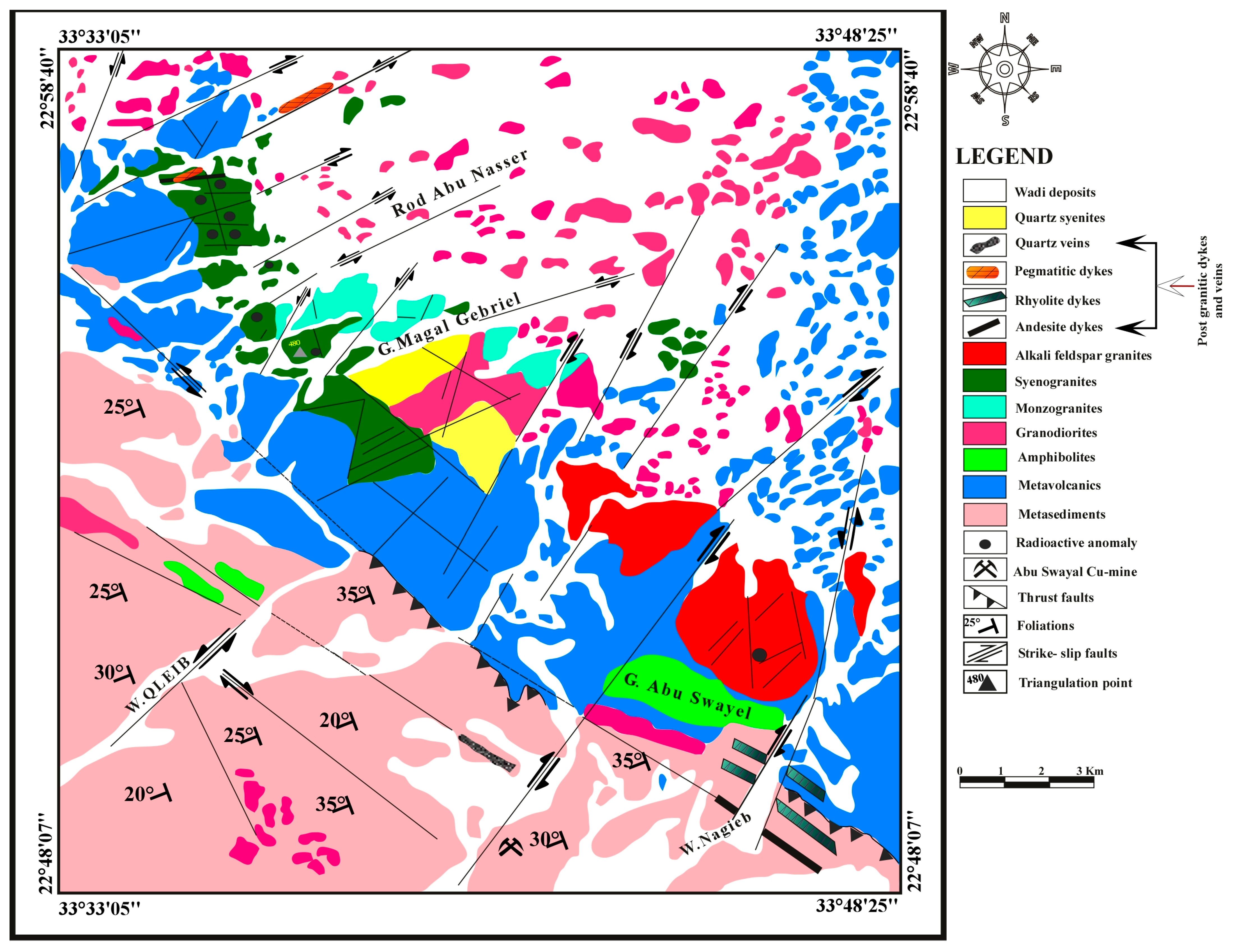
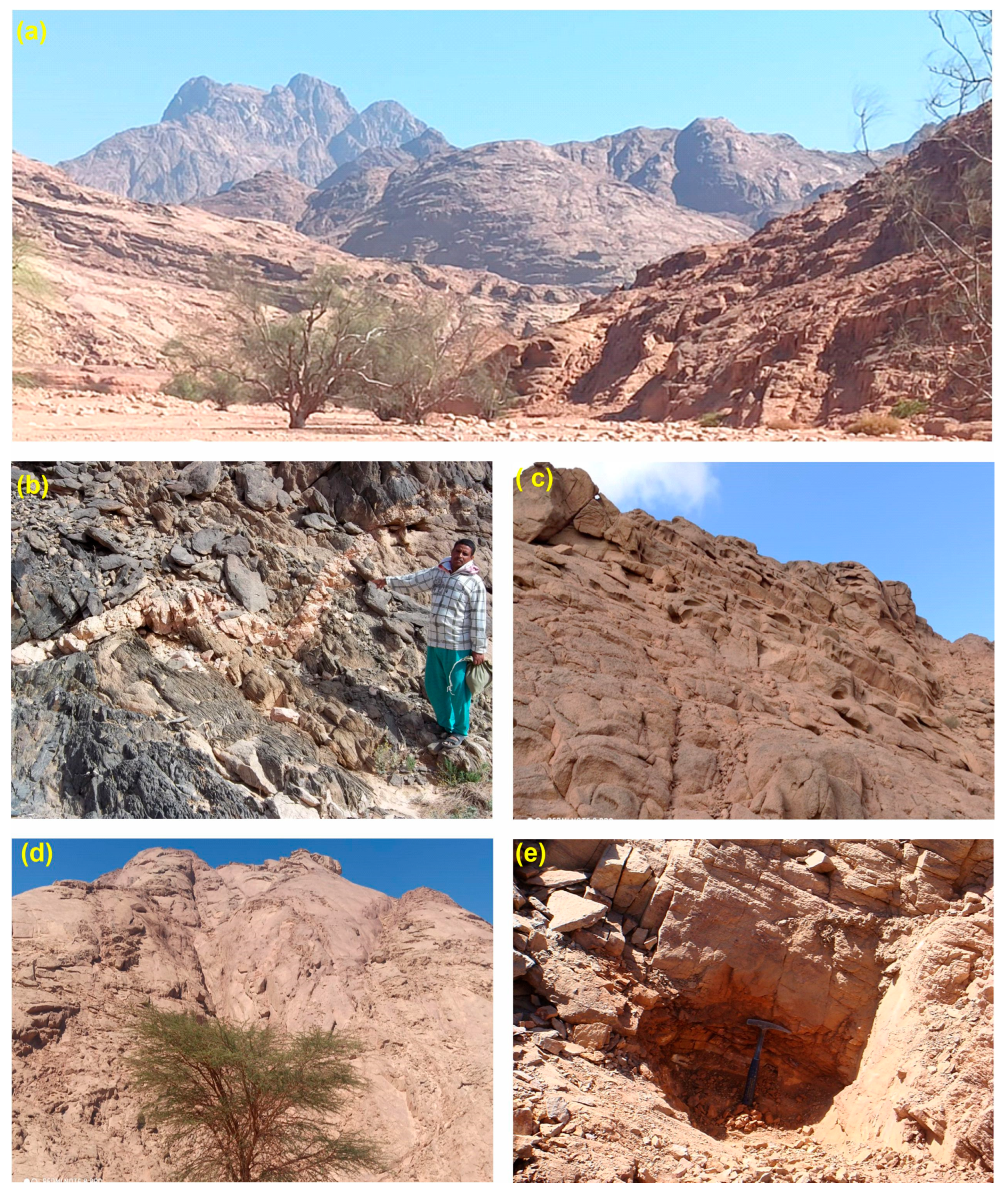
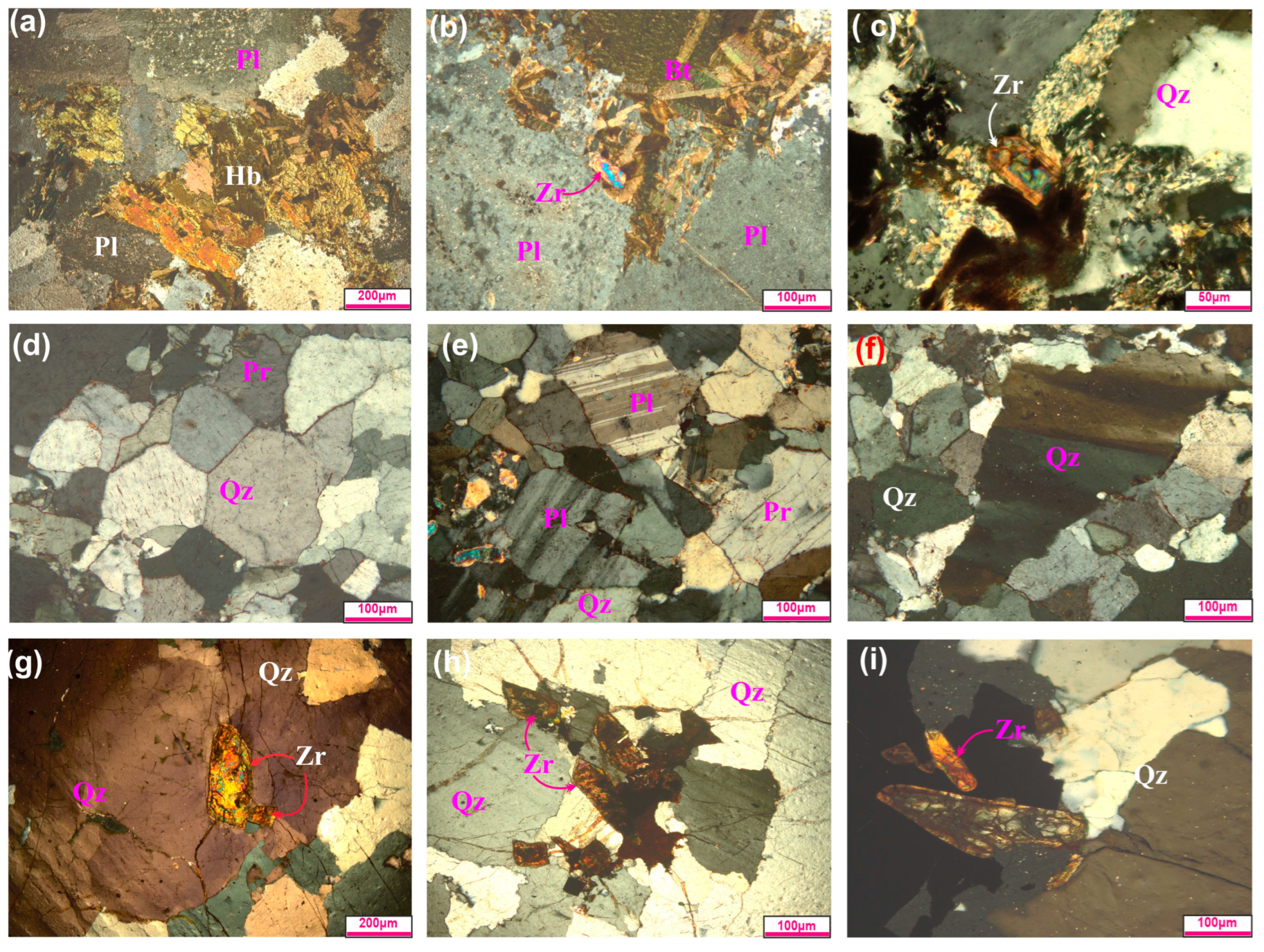
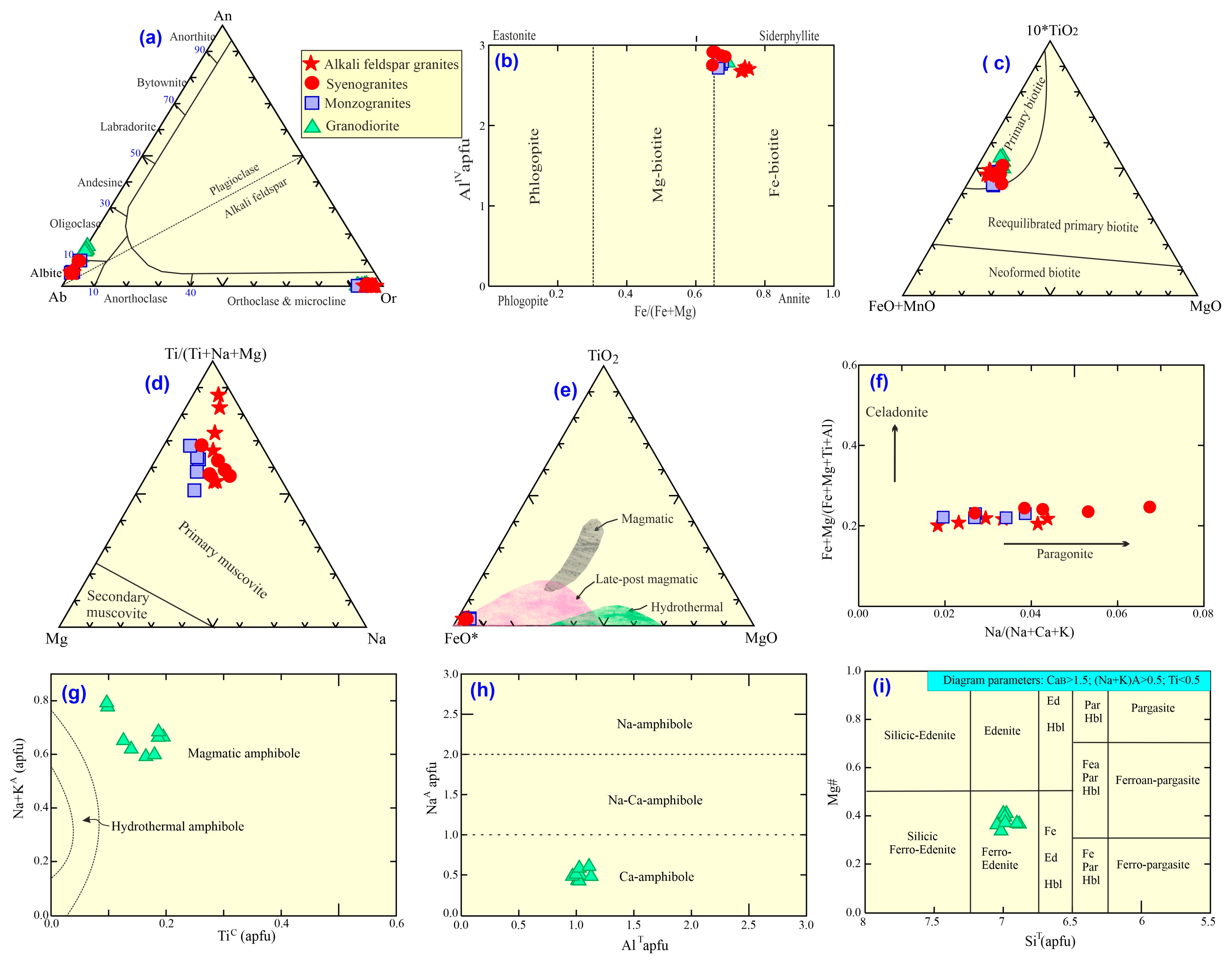
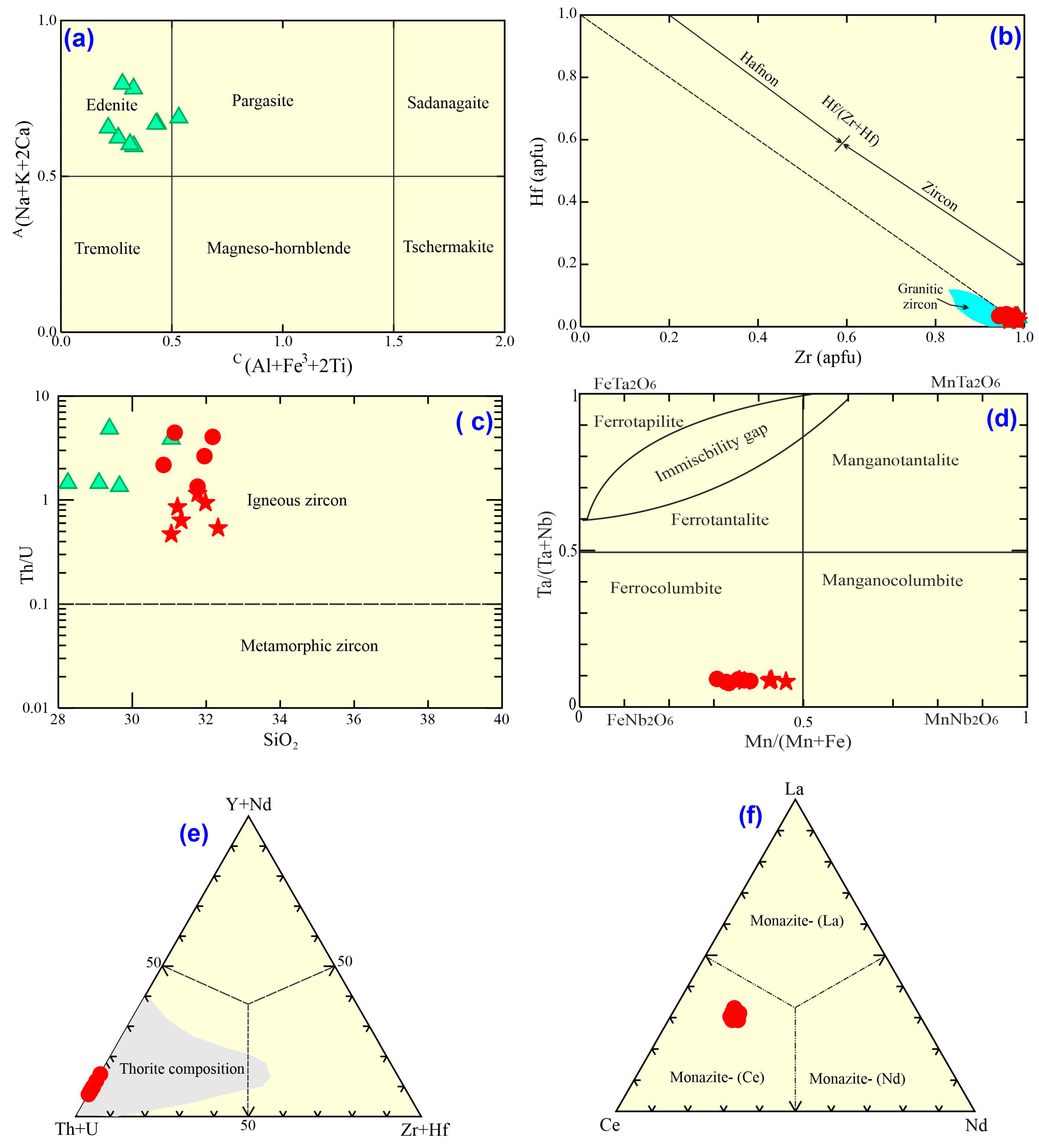
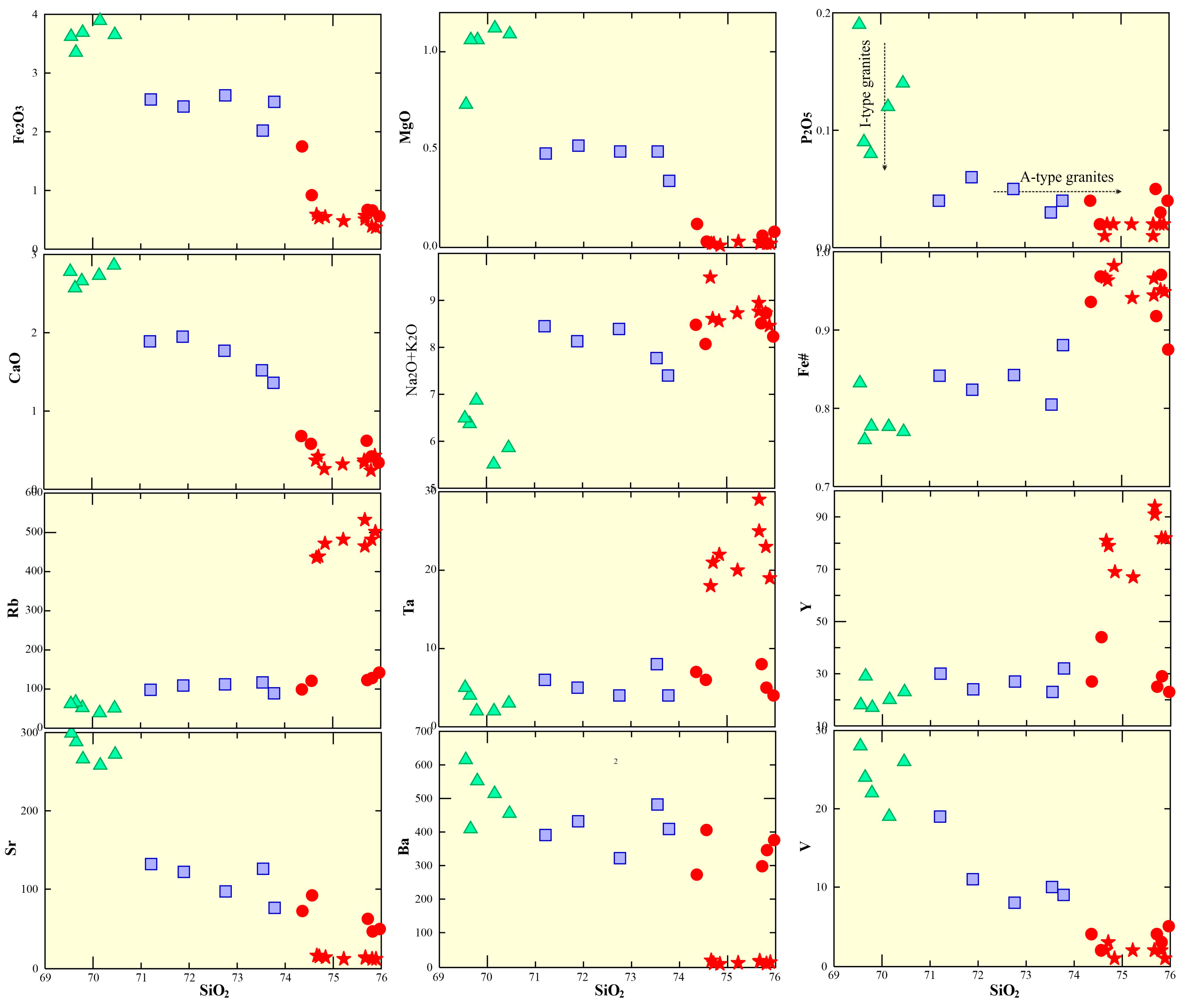
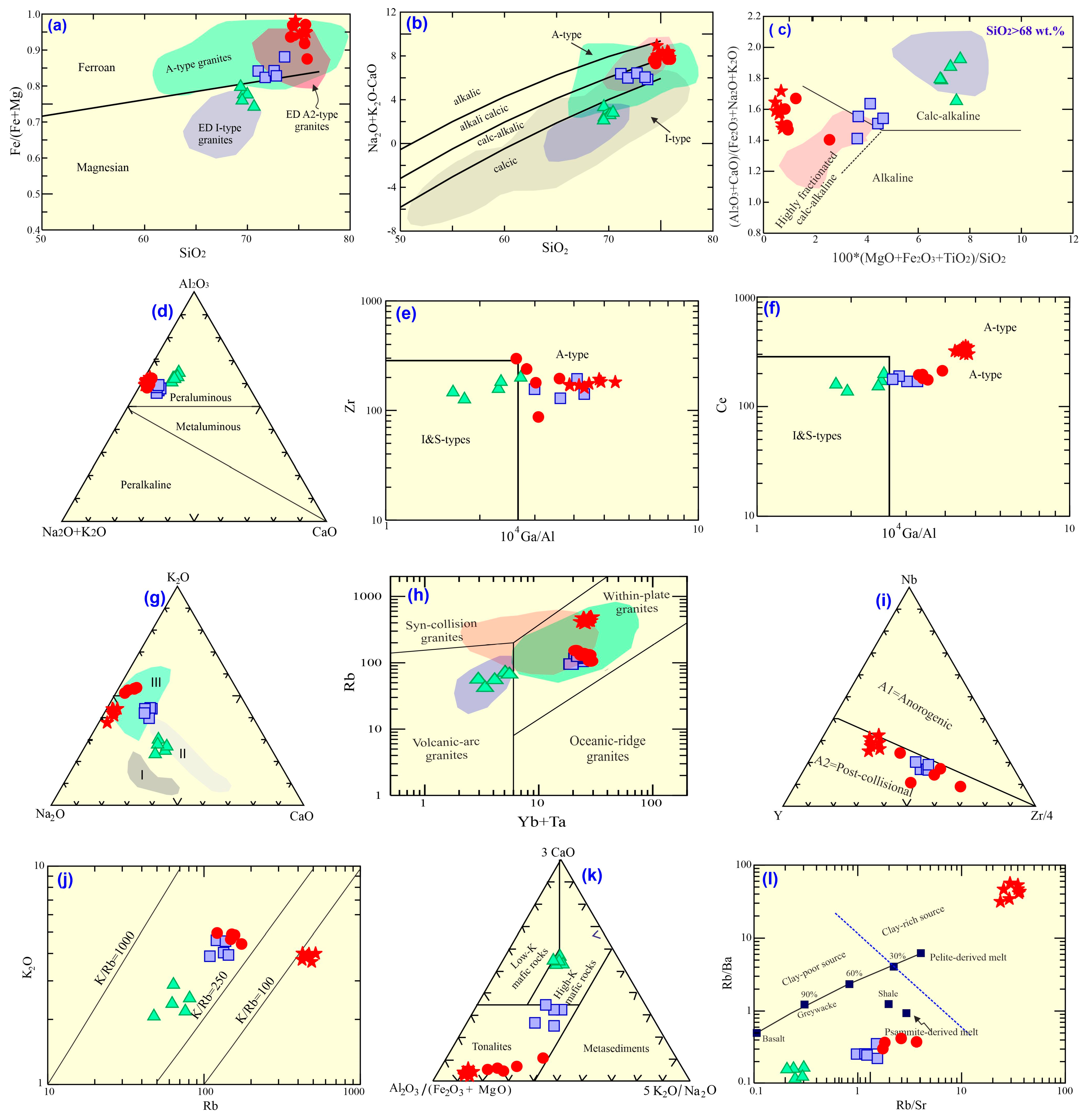
Disclaimer/Publisher’s Note: The statements, opinions and data contained in all publications are solely those of the individual author(s) and contributor(s) and not of MDPI and/or the editor(s). MDPI and/or the editor(s) disclaim responsibility for any injury to people or property resulting from any ideas, methods, instructions or products referred to in the content. |
© 2025 by the authors. Licensee MDPI, Basel, Switzerland. This article is an open access article distributed under the terms and conditions of the Creative Commons Attribution (CC BY) license (https://creativecommons.org/licenses/by/4.0/).
Share and Cite
Lasheen, E.S.R.; Saleh, G.M.; El-Tohamy, A.; Khaleal, F.M.; Sami, M.; Sanislav, I.V.; Abdalla, F. Mineral Chemistry and Whole-Rock Analysis of Magnesian and Ferroan Granitic Suites of Magal Gebreel, South Eastern Desert: Clues for Neoproterozoic Syn- and Post-Collisional Felsic Magmatism. Minerals 2025, 15, 751. https://doi.org/10.3390/min15070751
Lasheen ESR, Saleh GM, El-Tohamy A, Khaleal FM, Sami M, Sanislav IV, Abdalla F. Mineral Chemistry and Whole-Rock Analysis of Magnesian and Ferroan Granitic Suites of Magal Gebreel, South Eastern Desert: Clues for Neoproterozoic Syn- and Post-Collisional Felsic Magmatism. Minerals. 2025; 15(7):751. https://doi.org/10.3390/min15070751
Chicago/Turabian StyleLasheen, El Saeed R., Gehad M. Saleh, Amira El-Tohamy, Farrage M. Khaleal, Mabrouk Sami, Ioan V. Sanislav, and Fathy Abdalla. 2025. "Mineral Chemistry and Whole-Rock Analysis of Magnesian and Ferroan Granitic Suites of Magal Gebreel, South Eastern Desert: Clues for Neoproterozoic Syn- and Post-Collisional Felsic Magmatism" Minerals 15, no. 7: 751. https://doi.org/10.3390/min15070751
APA StyleLasheen, E. S. R., Saleh, G. M., El-Tohamy, A., Khaleal, F. M., Sami, M., Sanislav, I. V., & Abdalla, F. (2025). Mineral Chemistry and Whole-Rock Analysis of Magnesian and Ferroan Granitic Suites of Magal Gebreel, South Eastern Desert: Clues for Neoproterozoic Syn- and Post-Collisional Felsic Magmatism. Minerals, 15(7), 751. https://doi.org/10.3390/min15070751






